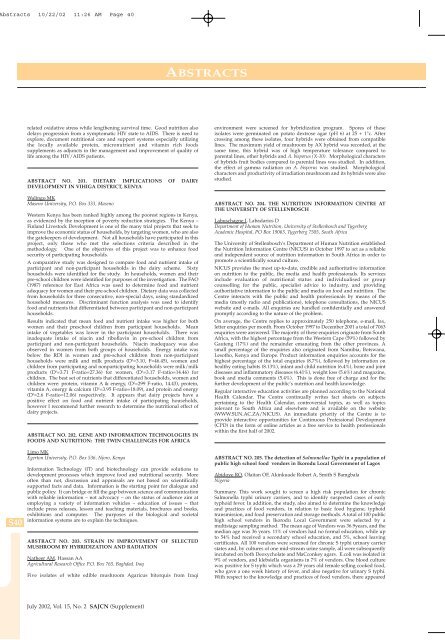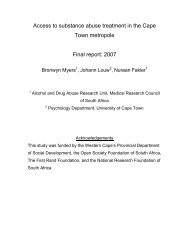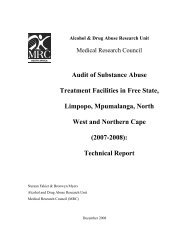Pan-African Conference 21 - 24 July 2002 Inter-Continental Hotel ...
Pan-African Conference 21 - 24 July 2002 Inter-Continental Hotel ...
Pan-African Conference 21 - 24 July 2002 Inter-Continental Hotel ...
Create successful ePaper yourself
Turn your PDF publications into a flip-book with our unique Google optimized e-Paper software.
Abstracts 10/22/02 11:26 AM Page 40<br />
S40<br />
related oxidative stress while lengthening survival time. Good nutrition also<br />
delays progression from a symptomatic HIV state to AIDS. There is need to<br />
explore, document nutritional care and support systems especially utilizing<br />
the locally available protein, micronutrient and vitamin rich foods<br />
supplements as adjuncts in the management and improvement of quality of<br />
life among the HIV/AIDS patients.<br />
ABSTRACT NO. 201. DIETARY IMPLICATIONS OF DAIRY<br />
DEVELOPMENT IN VIHIGA DISTRICT, KENYA<br />
Walingo MK<br />
Maseno University, P.O. Box 333, Maseno<br />
Western Kenya has been ranked highly among the poorest regions in Kenya,<br />
as evidenced by the inception of poverty reduction strategies. The Kenya –<br />
Finland Livestock Development is one of the many trial projects that seek to<br />
improve the economic status of households, by targeting women, who are also<br />
the gatekeepers of development. Not all households have participated in this<br />
project, only those who met the selections criteria described in the<br />
methodology. One of the objectives of this project was to enhance food<br />
security of participating households.<br />
A comparative study was designed to compare food and nutrient intake of<br />
participant and non-participant households in the dairy scheme. Sixty<br />
households were identified for the study. In households, women and their<br />
pre-school children were identified for purposes of the investigation. The FAO<br />
(1987) reference for East Africa was used to determine food and nutrient<br />
adequacy for women and their pre-school children. Dietary data was collected<br />
from households for three consecutive, non-special days, using standardized<br />
household measures. Discriminant function analysis was used to identify<br />
food and nutrients that differentiated between participant and non-participant<br />
households.<br />
Results indicated that mean food and nutrient intake was higher for both<br />
women and their preschool children from participant households. Mean<br />
intake of vegetables was lower in the participant households. There was<br />
inadequate intake of niacin and riboflavin in pre-school children from<br />
participant and non-participant households. Niacin inadequacy was also<br />
observed in women from both groups of households. Energy intake was<br />
below the RDI in women and pre-school children from non-participant<br />
households were milk and milk products (D2 =3.10, F=46.45), women and<br />
children from participating and nonparticipating households were milk/milk<br />
products (D2 =3.71 F-ratio=27.36) for women, (D2 =3.17 F-ratio=14.46) for<br />
children. The best set of nutrients that differentiated households, women and<br />
children were: protein, vitamin A & energy, (D2 =299 F-ratio, 14.43), protein,<br />
vitamin A, energy & calcium (D2 =3.95 F-ratio=18.09), and protein and energy<br />
(D2 =2.6 F-ratio=12.06) respectively. It appears that dairy projects have a<br />
positive effect on food and nutrient intake of participating households,<br />
however I recommend further research to determine the nutritional effect of<br />
dairy projects.<br />
ABSTRACT NO. 202. GENE AND INFORMATION TECHNOLOGIES IN<br />
FOODS AND NUTRITION: THE TWIN CHALLENGES FOR AFRICA<br />
Limo MK<br />
Egerton University, P.O. Box 536, Njoro, Kenya<br />
Information Technology (IT) and biotechnology can provide solutions to<br />
development processes which improve food and nutritional security. More<br />
often than not, discussion and appraisals are not based on scientifically<br />
supported facts and data. Information is the starting point for dialogue and<br />
public policy. It can bridge or fill the gap between science and communication<br />
with reliable information – not advocacy – on the status of audience aim at<br />
employing a variety of information vehicles – education of issues – that<br />
include press releases, lesson and teaching materials, brochures and books,<br />
exhibitions and computer. The purposes of the biological and societal<br />
information systems are to explain the techniques.<br />
ABSTRACT NO. 203. STRAIN IN IMPROVEMENT OF SELECTED<br />
MUSHROOM BY HYBRIDIZATION AND RADIATION<br />
Natheer AM, Hassan AA<br />
Agricultural Research Office P.O. Box 765, Baghdad. Iraq<br />
Five isolates of white edible mushroom Agaricus bitorquis from Iraqi<br />
<strong>July</strong> <strong>2002</strong>, Vol. 15, No. 2 SAJCN (Supplement)<br />
ABSTRACTS<br />
environment were screened for hybridization program. Spores of these<br />
isolates were germinated on potato dextrose agar (pH 6) at 25 + 1°c. After<br />
crossing among these isolates, four hybrids were obtained from compatible<br />
lines. The maximum yield of mushroom by AX hybrid was recorded, at the<br />
same time, this hybrid was of high temperature tolerance compared to<br />
parental lines, other hybrids and A. bisporus (X-10). Morphological characters<br />
of hybrids fruit bodies compared to parental lines was studied. In addition,<br />
the effect of gamma radiation on A. bisporus was studied. Morphological<br />
characters and productivity of irradiation mushroom and its hybrids were also<br />
studied.<br />
ABSTRACT NO. 204. THE NUTRITION INFORMATION CENTRE AT<br />
THE UNIVERSITY OF STELLENBOSCH<br />
Labuschagne I, Labadarios D<br />
Department of Human Nutrition, University of Stellenbosch and Tygerberg<br />
Academic Hospital, PO Box 19063, Tygerberg 7505, South Africa<br />
The University of Stellenbosch’s Department of Human Nutrition established<br />
the Nutrition Information Centre (NICUS) in October 1997 to act as a reliable<br />
and independent source of nutrition information in South Africa in order to<br />
promote a scientifically sound culture.<br />
NICUS provides the most up-to-date, credible and authoritative information<br />
on nutrition to the public, the media and health professionals. Its services<br />
include evaluation of nutritional status and individualised or group<br />
counselling for the public, specialist advice to industry, and providing<br />
authoritative information to the public and media on food and nutrition. The<br />
Centre interacts with the public and health professionals by means of the<br />
media (mostly radio and publications), telephone consultations, the NICUS<br />
website and e-mails. All enquiries are handled confidentially and answered<br />
promptly according to the nature of the problem.<br />
On average, the Centre replies to approximately 250 telephone, e-mail, fax,<br />
letter enquiries per month. From October 1997 to December 2001 a total of 7063<br />
enquiries were answered. The majority of these enquiries originate from South<br />
Africa, with the highest percentage from the Western Cape (59%) followed by<br />
Gauteng (17%) and the remainder emanating from the other provinces. A<br />
small percentage of the enquiries also originated from Namibia, Botswana,<br />
Lesotho, Kenya and Europe. Product information enquiries accounts for the<br />
highest percentage of the total enquiries (8.7%), followed by information on<br />
healthy eating habits (8.13%), infant and child nutrition (6.4%), bone and joint<br />
diseases and inflammatory diseases (6.41%), weight loss (5.6%) and magazine,<br />
book and media comments (5.4%). This is done free of charge and for the<br />
further development of the public’s nutrition and health knowledge.<br />
Regular interactive education activities are planned according to the National<br />
Health Calendar. The Centre continually writes fact sheets on subjects<br />
pertaining to the Health Calendar, controversial topics, as well as topics<br />
relevant to South Africa and elsewhere and is available on the website<br />
(WWW.SUN.AC.ZA/NICUS). An immediate priority of the Centre is to<br />
provide interactive opportunities for Continuous Professional Development<br />
(CPD) in the form of online articles as a free service to health professionals<br />
within the first half of <strong>2002</strong>.<br />
ABSTRACT NO. 205. The detection of Salmonellae Typhi in a population of<br />
public high school food vendors in Ikorodu Local Government of Lagos<br />
Abidoye RO, Olaitan OF, Akinkuade Robert A, Smith S Bamgbala<br />
Nigeria<br />
Summary. This work sought to screen a high risk population for chronic<br />
Salmonella typhi urinary carriers, and to identify suspected cases of early<br />
typhoid fever. In addition, the study, also aimed to determine the knowledge<br />
and practices of food vendors, in relation to basic food hygiene, typhoid<br />
transmission, and food preservation and storage methods. A total of 100 public<br />
high school vendors in Ikorodu Local Government were selected by a<br />
multistage sampling method. The mean age of Vendors was 36.9years, and the<br />
median age was 36 years. 11% of vendors had no formal education, while up<br />
to 54% had received a secondary school education, and 5%, school leaving<br />
certificates. All 100 vendors were screened for chronic S typhi urinary carrier<br />
states and, by cultures of one mid-stream urine sample, all were subsequently<br />
incubated on both Deoxycholate and MaCconkey agars. E.coli was isolated in<br />
9% of vendors, and klebsiella organisms in 7% of vendors. One blood culture<br />
was positive for S typhi which was a 29 years old female selling cooked food,<br />
who gave a one week history of fever, and also negative for urinary S typhi.<br />
With respect to the knowledge and practices of food vendors, there appeared

















